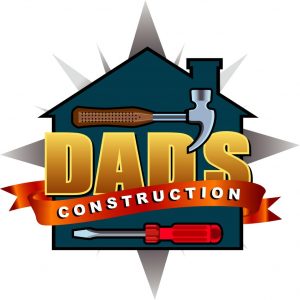Best Floor for Your Home
When thinking about the best floor for your home, it’s important to remember there are three primary types of interior residential flooring . . . hard, medium, and soft. These are defined as follows:
- Hard – Tile, stone, brick, concrete, wood (solid and engineered), laminate
- Medium – Cork, rubber, vinyl, linoleum, asphalt, poured seamless flooring
- Soft – Carpet, rugs, foam
Hard and some medium flooring is best for wet areas. A wet area is characterized as any area where water is present. This includes bathrooms, kitchens, laundry rooms, mud rooms, and entry locations. Entry areas can be subjective. For example, if there is a regularly used pool in the backyard, the door used to enter the house from the pool is a wet entry. Conversely, if there is no pool in the backyard and little backdoor use during the wet winter months, not a wet location. Another example is the front entry door. Many clients use the garage door as the primary entrance into the house. In these situations, the front door would not be considered a wet entry.
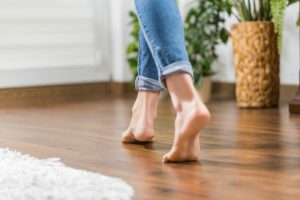 What determines hard, medium, and soft? The “bounce”. Hard flooring has no “give or bounce back.” In other words, it is solid. It provides positive support with high strength and durability. Think about the last time you walked on a tile or solid wood floor. It did not move. A medium floor has some “bounce.” Walking on a vinyl, linoleum, or laminate (Pergo® type flooring) and a “bounce” can be felt. It feels a bit softer – not so hard. Soft on the other hand has a definite “bounce”. Walking on carpet is very soft and pleasant. It has the greatest “bounce”.
What determines hard, medium, and soft? The “bounce”. Hard flooring has no “give or bounce back.” In other words, it is solid. It provides positive support with high strength and durability. Think about the last time you walked on a tile or solid wood floor. It did not move. A medium floor has some “bounce.” Walking on a vinyl, linoleum, or laminate (Pergo® type flooring) and a “bounce” can be felt. It feels a bit softer – not so hard. Soft on the other hand has a definite “bounce”. Walking on carpet is very soft and pleasant. It has the greatest “bounce”.
What is the best floor for your home?
In this article, I am going to focus on the best and most commonly used flooring in residential homes. Particular attention will be paid to bathroom and kitchen areas.
Hard Flooring in your Home
 When properly installed, hard flooring materials such as tile and stone are the most durable and water repellent products for the bathroom and kitchen. It also gives the space an instant “Wow” factor.
When properly installed, hard flooring materials such as tile and stone are the most durable and water repellent products for the bathroom and kitchen. It also gives the space an instant “Wow” factor.
Unlike medium and soft flooring, hard flooring is a long-term commitment due to its durability. Many hard floors installed 50-100 years ago are still performing beautifully. Although the cost to install is generally more than medium and soft flooring, the overall cost of ownership makes tile the lowest overall cost flooring.
Hard flooring is colder underfoot. This can easily be remedied by installing radiant floor heating. Radiant heating works well on wood, tile, stone, vinyl, and carpet. Not all engineered wood and laminate flooring works with radiant heating systems. Check with the manufacturer before installing a radiant system on these two types of flooring. The cost for radiant floor heat is very reasonable for bathroom and kitchen spaces. A rug in front of the sink, shower, and toilet is also an option for cold floors.
I have rarely seen brick and have never seen polished concrete in a residential home. Brick would be far too soft and porous and polished concrete to slippery and cold. Moreover, most builders perform an inferior job of pouring concrete and the slab develops lots of cracks (which would be unsightly). Therefore, these are omitted from my discussion.
Wood
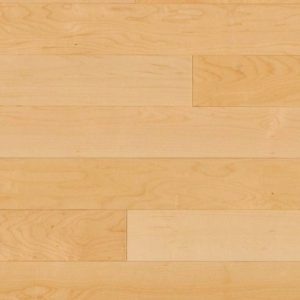 Although wood is considered a hard-flooring material, it is a terrible product for the bathroom. Why? Both solid and engineered wood absorbs water and ambient moisture. It rots and generates large amounts of mold spores, fungus, and bacteria – especially under and around the toilet and next to the tub and/or shower. Wood in a bathroom can quickly turn into a serious, silent health issue. Silent because the destruction and health consequences typically begin under the wood floor, unseen and unknown for years.
Although wood is considered a hard-flooring material, it is a terrible product for the bathroom. Why? Both solid and engineered wood absorbs water and ambient moisture. It rots and generates large amounts of mold spores, fungus, and bacteria – especially under and around the toilet and next to the tub and/or shower. Wood in a bathroom can quickly turn into a serious, silent health issue. Silent because the destruction and health consequences typically begin under the wood floor, unseen and unknown for years.
In the kitchen, wood becomes problematic. Dropping sharp utensils (knives, forks, etc.), glass objects and serving ware (plates, cups, etc.) will indent and damage the surface. This allows water, food, grease, grime, and insects into the core of the flooring. When this happens, the floor begins deteriorating, looks dingy, and quickly loses its appeal and luster. Moreover, mold, mildew, and bacteria enter the wood floor and begins is unhealthful destruction of the floor and possibly your health. If the dishwasher, sink, or refrigerator water line leaks, the floor is ruined (there is no method to properly dry it out).
 |  |
Are there any drawbacks to wood flooring?
When wood flooring receives lots of grime filled indentations, you may begin to see species of weevils in the kitchen. From the picture below, these insects are really small and actually look like dirt. The females lay their eggs in these holes. A single female weevil can lay over 250 eggs during her 8-month life.
Pets, especially dogs are very hard on wood floors. Their claws will scratch the floor. Keeping your pet’s food and/or water dish on a wood floor almost guarantees weevils.
Because wood floors in the kitchen can harbor insects, mold, mildew, bacteria (there are 40 Staphylococcus or staph species), they are not a good idea if there are infants or small children in the home.
Hardwood flooring in particular requires careful maintenance including regular cleaning, varnishing, and refinishing to keep it looking its best. The look of natural hard flooring also deteriorates over time: wood gets scuffed, scratched, or indented by foot traffic (like high heels, pebbles, and sand on soles of shoes, children’s toys, pets).
Stone
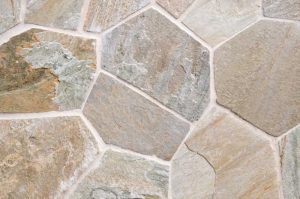 Not all stone is suitable for a bathroom. Any polished stone presents a slip and fall hazard likely resulting in injury. No highly polished stone product is permitted on a bathroom floor, steps, or stairs per building codes. For more information on the dangers of highly polished flooring in bathrooms, see the “Tile” section below.
Not all stone is suitable for a bathroom. Any polished stone presents a slip and fall hazard likely resulting in injury. No highly polished stone product is permitted on a bathroom floor, steps, or stairs per building codes. For more information on the dangers of highly polished flooring in bathrooms, see the “Tile” section below.
Anything highly polished will be slippery when wet, wearing socks, or when your feet or shoes are wet or damp. It is not a good product if you have pets, infants, or small children.
Limestone, travertine, tumbled stone, slate, sandstone, quartzite, and marble should not be used for bathroom flooring. Why? All of these stones absorb water and have veining which makes them weak. The porous nature of these products subjects them to staining and trapping of dirt and grim. Irrespective of sealing, these products will become dingy and typically harbor mold, mildew, and bacteria.
Virtually all stone floors have veining – that’s part of its beauty. This also means stone can crack or stain. Stone is also cold underfoot. This can easily be remedied by installing radiant floor heating. The cost is very reasonable for bathroom spaces.
Stone in the remainder of the house works nicely provided it is properly installed, well maintained, and frequently cleaned and sealed. Stone flooring can be rather expensive to install. A proper installation requires a mortar base. This requires other adjustments in the house. Stone is also very cold and can be hard on feet and joints. Natural un-honed stone can cause bleeding injuries to toe’s and nails. Honed stone (honed means that a stone’s surface has been ground down slightly to achieve a consistent, smooth texture and flat, matte, or polished finish.) works best in residential homes.
Tile
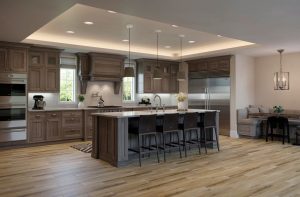
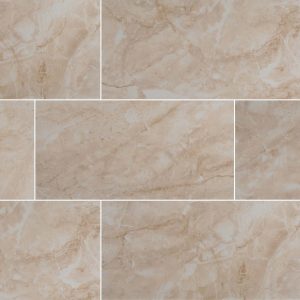 Professional and independent testing continually find that porcelain tile is the most durable type of flooring. It is resistant to scratches, dents, and moisture. It is also very easy to clean. Glazed ceramic and porcelain tile require very little maintenance.
Professional and independent testing continually find that porcelain tile is the most durable type of flooring. It is resistant to scratches, dents, and moisture. It is also very easy to clean. Glazed ceramic and porcelain tile require very little maintenance.
Ceramic and porcelain tiles are the best products for bathroom, kitchen, laundry, and entry floors. When properly installed, tile creates a highly durable and beautiful environment. Tile flooring is hardwearing and easy to clean. The two most common types are ceramic and porcelain tiles. Both are made from natural clay. However, porcelain tiles are made from denser clay and finely ground sand. This makes porcelain tile much more durable, resistant to scratching and chipping, and less porous than ceramic tiles. Without question, porcelain tile is best for bathroom and kitchen floors.
You must be very careful when installing tile in a bathroom. Highly polished tiles are extremely dangerous. When highly polished tile gets wet, it is like ice. Stepping out of the shower or bathtub with wet feet or onto a wet tile surface can cause serious injury and death. In fact, according to the Centers for Disease Control (CDC), 235,000 people over the age of 15 are injured in the bathroom each year. Of these, about 81% (over 190,000 people) are injured from bathroom slip and fall injuries. Almost 14% (27,000 people) are hospitalized.
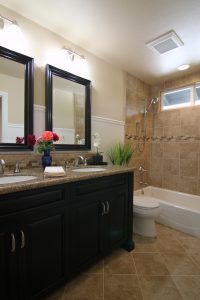 Bathroom slip and fall accidents are responsible for traumatic brain injuries suffered when the falling person struck a counter, the edge of a bathtub or another bathroom fixture. Adults over age 85 were more likely to break one or more bones due to a bathroom fall. Like polished stone, highly polished tile is not permitted on a bathroom floor per building codes.
Bathroom slip and fall accidents are responsible for traumatic brain injuries suffered when the falling person struck a counter, the edge of a bathtub or another bathroom fixture. Adults over age 85 were more likely to break one or more bones due to a bathroom fall. Like polished stone, highly polished tile is not permitted on a bathroom floor per building codes.
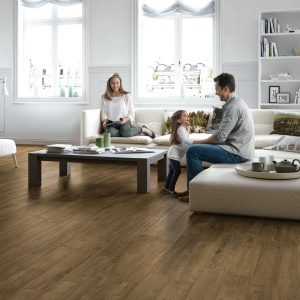
The proper underlayment is very important when installing tile.
When installing a tile floor, it’s all about the underlayment and the grout. Make sure the underlayment and the setting compound is correct for your product. If its wrong, your tile floor will crack! Grout sits lower than the tile. Water seeks the path of least resistance (deposits soil to the lowest point). Because of this, it is imperative that you use a high-quality grout. Lessor grouts will stain, absorb water, and not properly bond to the tile. A high-quality grout also really improves the appearance and longevity of the floor. Bottom line: Using the right high-quality underlayment and grout matters a lot!
Laminate
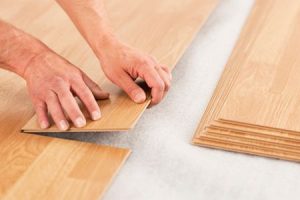 A good quality laminate floor can achieve a similar look to a hardwood floor, at a fraction of the price. It’s also easier to install than hardwood flooring. Laminate flooring includes Pergo®(owned by Mohawk), Shaw Repel®, Armstrong Laminate®, AquaGuard Laminate®, Dream Home® (Lumber Liquidators), Tarkett® (Lumber Liquidators), TrafficMaster® (Home Depot), and Harmonics® (Costco). Dream Home, Tarkett, TrafficMaster, and Harmonics, are some of the worst laminate products on the market.
A good quality laminate floor can achieve a similar look to a hardwood floor, at a fraction of the price. It’s also easier to install than hardwood flooring. Laminate flooring includes Pergo®(owned by Mohawk), Shaw Repel®, Armstrong Laminate®, AquaGuard Laminate®, Dream Home® (Lumber Liquidators), Tarkett® (Lumber Liquidators), TrafficMaster® (Home Depot), and Harmonics® (Costco). Dream Home, Tarkett, TrafficMaster, and Harmonics, are some of the worst laminate products on the market.
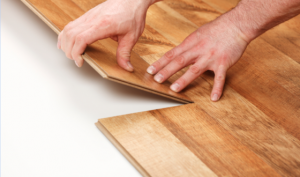 Laminates are not good products for the bathroom. Why? By virtue of having a wood powder core, it does not handle moisture very well. Laminate flooring can warp, buckle, and distort when exposed to wet conditions. This includes moisture (hot water mist), water from bathing, towel drying, wet cleaning, and subfloor moisture. The result is de-lamination and dangerous swells that create a trip and fall hazard. It can also harbor unhealthful mold, mildew, and bacteria.
Laminates are not good products for the bathroom. Why? By virtue of having a wood powder core, it does not handle moisture very well. Laminate flooring can warp, buckle, and distort when exposed to wet conditions. This includes moisture (hot water mist), water from bathing, towel drying, wet cleaning, and subfloor moisture. The result is de-lamination and dangerous swells that create a trip and fall hazard. It can also harbor unhealthful mold, mildew, and bacteria.
Click-and-lock laminate planks are very popular today and the easiest fitting system to install. Some laminates now include a waterproof core. Beware – laying them in a bathroom (or kitchen) will be problematic. The joints wear over time, making them susceptible to letting in moisture. This makes the boards swell, warp, buckle, and distort. Where it meets the bathtub or shower, regardless of caulking or sealant used, you will get mold, fungus, mildew, and bacteria underneath.
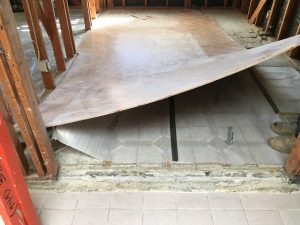
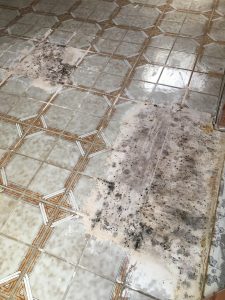
Is laminate flooring good for bathrooms and kitchens?
I have personally removed a lot of laminate flooring from bathrooms and kitchens where there was serious black mold, fungus, and mildew underneath. I’ve also experienced these conditions in other parts of the house. It does not breath and traps all moisture between the top and bottom layers of the product. For more information on the dangers of mold, read Mold in Bathroom.
Laminate flooring is also noticeably louder than many of the other hard flooring types, with its layers transmitting rather than absorbing sound. In many Community Associations (AKA – HOAs), laminate flooring is not permitted in second floor units.
It is generally significantly cheaper than real wood and engineered wood. That’s because it is manufactured by fusing multi-layered materials together. The inner-core is made from High Density Fiberboard (HDF – this is little more than sawdust with a glue as its binder). The surface is a high-resolution image of wood, stone, or other material. There is a protective overlay covering on top. It is really nothing more than thick fancy wallpaper.
Medium Flooring
A medium flooring has some bounce. It feels easier on the feet and looks great. It is also generally cheaper to install than hard flooring. Not all medium flooring is created equal. For residential bathrooms, kitchens, and laundry rooms, vinyl and linoleum materials are the most common type of medium flooring. The quality of these flooring types means everything when it comes to safety and durability.
The word “resilient” is tossed around a lot today. Resilient flooring is a loose, catch-all term that refers to floor coverings that occupy a middle ground between soft floors (such as carpeting) and hard floors (such as stone, tile, or hardwood).
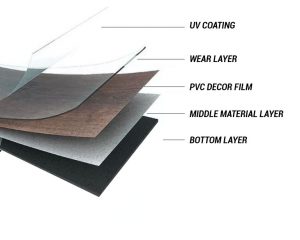 | 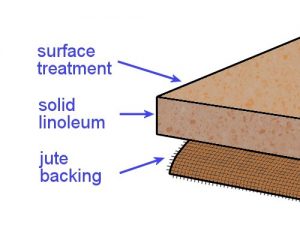 | 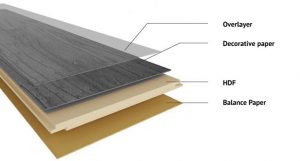 |
| How Luxury Vinyl is Made | Linoleum is Made Using a 3-Step Process | Laminate Consists of 4 Layers |
According to the Resilient Floor Covering Institute (RFCI), there are only six types of floor covering that can be called resilient. These are:
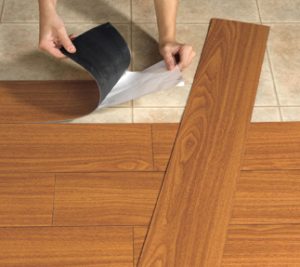 | 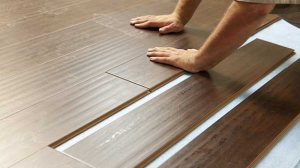 | 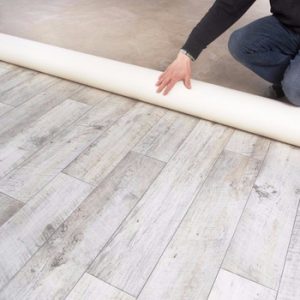 |
| Luxury Vinyl Tile (LVT) | Luxury Vinyl Planks (LVP) | Linoleum |
- Vinyl: Comprises the majority share of the resilient flooring market. This includes Vinyl Composition Tile (VCT), Solid Vinyl Tile (SVT), and Luxury Vinyl Tile (LVT) or Planks (LVP).
- Linoleum: This predecessor of vinyl flooring is a natural product made of linseed oil, wood, limestone, cork, and resins. Today, it comes in three forms: glue-down tiles, click-together planks, and large sheets.
- Cork: An organic product made of thinly sliced cork from trees, cork has become a favored “green” or eco-friendly flooring product.
- Rubber: Once made of organic rubber from rubber trees, this category of flooring is now mainly produced from synthetic rubbers. Recycled rubber is sometimes used in homes, most often for gym or yoga studio flooring.
- Asphalt: Mastic asphalt is a mixture of fine and coarse limestone and dolomite aggregate and synthetic bitumens. It is a dustless, elastic, durable, waterproof, and acid proof product. This product is attractive, non-slippery, and noiseless. Primarily used in factories, loading docks, and terrace floors. It is poured in place.
- Poured Seamless Flooring: Also called “Weldless”, these floors have no seams, ridges, or joints. They are poured-in-place epoxy, urethane, or methyl methacrylate formulations. They become a natural part of a building’s structure.
How is resilient flooring defined?
RFCI further defines resilient flooring as being firm yet has a “give or bounce back.” Thus, carpeting is not resilient flooring because it has “give” but is not firm. Hardwood flooring is not a resilient floor because it is firm but has little “give.” Some floor coverings that fit this definition escape the resilient category. With its fiberboard core and foam underlayment, laminate flooring provides both firmness and “spring.” Yet it is considered to be a hard floor covering.
 Resilient flooring today has a factory-applied polyurethane coating. This provides a more durable surface that resists abrasion and reduces maintenance. However, it does require daily and more frequent routine maintenance to ensure longevity.
Resilient flooring today has a factory-applied polyurethane coating. This provides a more durable surface that resists abrasion and reduces maintenance. However, it does require daily and more frequent routine maintenance to ensure longevity.
Of the six, only Vinyl and Linoleum are typically found in a residential home. Cork is too porous (inviting serious mold, mildew, fungus, and bacteria problems). Rubber is primarily used for exercise areas (like gyms and garages). Asphalt is an industrial application (commercial kitchens, factory floors, and garages).
Resilient flooring is:
 Durable: Some linoleum installed over a century ago is still wearing strong.
Durable: Some linoleum installed over a century ago is still wearing strong.- Flexible: Resilient flooring bridges slight bumps and gaps.
- Inexpensive: One type of resilient flooring, vinyl, is consistently the cheapest floor covering you can buy.
- Indentation: Small pressure points, such as table and sofa legs or appliance feet, can permanently indent resilient flooring.
- Inconsistent Value: Resilient flooring is all over the map when it comes to perceived buyer value. Even within the sub-category of vinyl, you can install high-quality, premium luxury vinyl brands such as Mannington, Shaw, or Karndean or low-quality (but cheap) vinyl sheet and squares that may peel away long before they wear down.
- Euphemism for Vinyl Flooring: The term vinyl flooring became associated with buyers’ minds for inferior flooring. Flooring manufacturers and retailers began to substitute the word “resilient floor” for vinyl floor. Recently, retailers and manufacturers have been slowly moving back to using the term “vinyl.” With the introduction of higher-end products like luxury vinyl flooring (LVF). Much of the stigma tied to the word “vinyl” seems to no longer be in place.
Vinyl
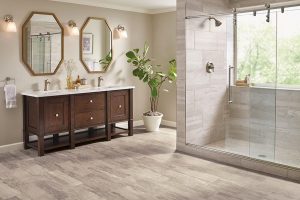 Plank, sheet, and squares are the most common methods of vinyl installation. Plank or luxury vinyl is all the rage today. Luxury Vinyl Plank (LVP) is very popular due to its low cost. Almost all LVP sales are for a simulated wood floor look. Consider the following per square foot costs for flooring (most to least expensive):
Plank, sheet, and squares are the most common methods of vinyl installation. Plank or luxury vinyl is all the rage today. Luxury Vinyl Plank (LVP) is very popular due to its low cost. Almost all LVP sales are for a simulated wood floor look. Consider the following per square foot costs for flooring (most to least expensive):
- Solid Wood: $12-$23 ($6-$11 material; $6-$12 installation)
- Engineered Wood: $6-$23 ($3-$14 material; $3-$9 installation)
- Linoleum: $6-$12 ($3-$7 material; $3-$5 installation)
- Luxury Vinyl Plank (click lock): $4-$9 ($2-$6 material; $2-$3 installation)
- Laminate (i.e. Pergo): $2-$8 ($1-$5 material; $1-$3 installation)
- Vinyl: $2-$4 ($0.50-$2 material; $1.50-$2 installation)
Why Choose LVP Flooring?
 LVP flooring provides a wood floor look for almost half the price of wood flooring. It is also about double+ the price of lower end laminate and vinyl flooring. It’s easy to see why it has become so popular.
LVP flooring provides a wood floor look for almost half the price of wood flooring. It is also about double+ the price of lower end laminate and vinyl flooring. It’s easy to see why it has become so popular.
I’ve received samples from various manufactures and enjoyed lengthy discussions with their sales representatives and those who have installed LVP. I also tested LVP under normal conditions. Here are my findings:
- Every Sales Rep from all the manufactures said that LVP cannot be installed near or under a heat source (Range, dishwasher, dryer, water heater, furnace, fireplace, radiant floor heating (click lock only)).
- Fades next to windows. Direct sunlight will damage the LVP.
 Breaks and chips easily (it is not a strong product).
Breaks and chips easily (it is not a strong product).- Water and moisture will seep into the LVP at the click lock (tongue and groove).
- Dangerous mold, mildew, fungus, and bacteria will develop under the product. This is especially true in homes built prior to 2010.
- Heavy items and furniture will damage the planks.
- Tracked in dirt on shoe soles will easily scratch the surface. Heals will also scratch and damage the surface.
- Requires special methods and cleaners for proper maintenance.
- Candles, cigarettes, matches, etc. will burn LVP.
- Many common household items will stain LVP.
- Most manufactures suggest keeping at least 5 extra planks for repair and testing of cleaning products.
I do not recommend LVP in any bathroom, kitchen, or laundry room. The only vinyl floor product that works in a bathroom is properly installed high quality sheet vinyl. Any other derivative or style and you are asking for trouble.
Linoleum
 This product has been around since 1860. I’ve removed linoleum in homes that is over 50-75 years old. Other than being worn and dated, it was still doing its job. It is a hard-wearing and low-maintenance product. Like its cousin vinyl, linoleum looks and feels like plastic. Both convincingly mimic wood and stone floors. Sheet vinyl and linoleum are easy to keep clean and maintain. Thicker products have much better durability. Premium products are available at about 155mm, rather than 80mm at the budget end. Proper subfloor preparation and measuring are critical to ensuring linoleums longevity.
This product has been around since 1860. I’ve removed linoleum in homes that is over 50-75 years old. Other than being worn and dated, it was still doing its job. It is a hard-wearing and low-maintenance product. Like its cousin vinyl, linoleum looks and feels like plastic. Both convincingly mimic wood and stone floors. Sheet vinyl and linoleum are easy to keep clean and maintain. Thicker products have much better durability. Premium products are available at about 155mm, rather than 80mm at the budget end. Proper subfloor preparation and measuring are critical to ensuring linoleums longevity.
Linoleum flooring is softer than tile or hardwood but is not as soft as vinyl flooring. It is a very natural product and is environmentally friendly with a distinct eco-friendly factor. It is made from renewable materials and has anti-bacterial properties.
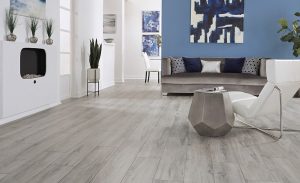 The name linoleum is a concoction of the “lin” from linseed and “oleum” from oil. So, just as the word petroleum is “rock oil” (petra = rock, oleum = oil), linoleum is “linseed oil.” Linseed is flax. Flax is often touted as a miracle seed, capable of all sorts of medicinal properties. Whether that is true or not, what is certain is that flax is such a tough, fibrous seed that it is processed and woven into textiles. In fact, that’s where we get the word linen from: linseeds.
The name linoleum is a concoction of the “lin” from linseed and “oleum” from oil. So, just as the word petroleum is “rock oil” (petra = rock, oleum = oil), linoleum is “linseed oil.” Linseed is flax. Flax is often touted as a miracle seed, capable of all sorts of medicinal properties. Whether that is true or not, what is certain is that flax is such a tough, fibrous seed that it is processed and woven into textiles. In fact, that’s where we get the word linen from: linseeds.
It is light in weight and can be cleaned easily. However, it can be slippery and may cause accidents if not dried completely when wet.
Linoleum is the original resilient flooring material, made primarily from natural plant materials. Although it was largely replaced by vinyl flooring for many years, linoleum has started to make a comeback due to its natural qualities and other virtues.
What are the benefits of Linoleum?
- Cleanliness: Linoleum is easy to clean and maintain. It doesn’t hold onto dust, pollen, and other air contaminants (like carpeting).
- Durability: Linoleum is water and stain-resistant enough to work well in kitchens and bathrooms but standing water can get into the seams of linoleum tiles and planks. Sheet linoleum is more water-resistant.
 Smooth and hard: Linoleum has a flat, smooth surface and is installed directly over subflooring or wood underlayment, so it is good for wheelchairs and walkers.
Smooth and hard: Linoleum has a flat, smooth surface and is installed directly over subflooring or wood underlayment, so it is good for wheelchairs and walkers.- Feel: It has a warm, tactile, comfy feeling underfoot and it doesn’t harbor dust mites. It’s a good choice if anyone suffers from allergies in the home.
- Natural: Many homeowners like the fact that linoleum is made with natural materials, such as linseed oil, pine rosin, wood flour, cork dust, jute, or ground limestone. This makes it a natural alternative to its closest cousin, vinyl flooring.
Are there drawbacks to Linoleum?
- Cost: Linoleum can be a relatively expensive flooring material (see above). Proper surface preparation can easily add another $2-$10 per square foot to the total overall cost.
- Hardness: While not as hard or cold as tile, linoleum offers very little cushion and can be relatively cold underfoot. Radiant heat works well with linoleum.
- Waxing: Must be waxed to keep it in good condition.
Soft Flooring
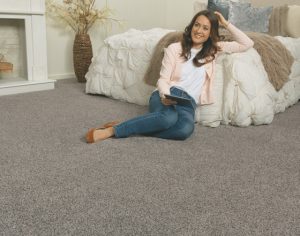 Soft flooring for residential homes primarily consists of carpet, rugs, and foam.
Soft flooring for residential homes primarily consists of carpet, rugs, and foam.
Kicking off your shoes and having a comfortable floor to walk on is one of the best feelings, yet it can mean completely different things depending on who you are and how you use a room. There is nothing like sinking your toes into an incredibly soft carpet in your bedroom. Soft flooring has high elasticity, flexibility, and muffles footfalls to a great extent as compared to any hard floor.
Soft flooring has a softer feel underfoot, feels warm on cool days, retains, and conducts heat, and is comfortable to look at. Nice carpet just feels great!
Advantages of Soft Flooring
- Warmth: The types of materials used in soft flooring have a higher thermal resistance. This helps in maintaining a higher room temperature in comparison to other types of floors.
 Comfort: Soft floors provide additional comfort and give a sense of luxury.
Comfort: Soft floors provide additional comfort and give a sense of luxury.- Noise: The materials used in soft floors are a source of insulation and thus act as a sound barrier.
- Safety: Carpets with high quality pad provides cushioning that reduces the impact when falling. It also enhances the flexibility and elasticity of the floor. Carpet is also the easiest on feet, knees, and back.
- Hygiene: In the case of carpets and rugs, the fibers trap the dust particles and prevent their circulation in the room.
- Style: One is often spilt for choice as unlimited colors, textures, and types of soft floors are available. Using a soft floor can enhance the aesthetics of a room and elevate the overall appearance.
Disadvantages of Soft Flooring
- It is undesirable to have soft floors in places accommodating pets.
- Professional cleaning: Manufacturers recommend yearly professional cleaning. For high traffic areas and homes with pets and small children, twice a year is recommended.
- Regular vacuuming: Vacuum cleaning removes the allergens and other minute particles present on the floor. This also prevents the formation of a layer of dirt. Foam requires regular wiping and disinfecting
- Rugs and mats: Mats and rugs have micro-fibers in them, which when placed in high traffic areas are capable of trapping soil, moisture, and other dirt particles.
Carpet
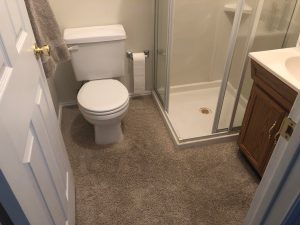 There is, perhaps, no worse product for a bathroom than carpet. But wait! Lots of builders install carpet in new home bathrooms! They do this because it is very inexpensive and fast. Not because it’s a great idea.
There is, perhaps, no worse product for a bathroom than carpet. But wait! Lots of builders install carpet in new home bathrooms! They do this because it is very inexpensive and fast. Not because it’s a great idea.
When carpet is installed in a bathroom, after about 10 years, the damage to the subfloor is typically extensive. This is especially true for the areas outside of showers, bathtubs, and toilets. The worst damage I see is outside showers and toilets. Consistently, toilets demonstrate the nastiest. Years of urine splash and poor aim along with toilet overflows quickly destroy the floor and subfloor. Toilet sweating contributes to the damage. Outside of showers are a close second. Opening the door wet and stepping out of the shower dripping causes both rot and insect damage.
Foam Flooring
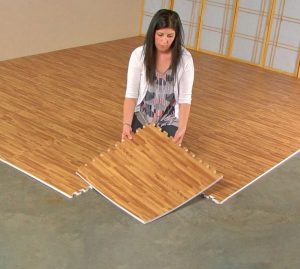 EVA, or Ethylene Vinyl Acetate, or Poly, is an elasticized, closed-cell foam with a rubber-like softness and flexibility. EVA foam mats and soft floor tiles are available in a wide variety of colors, designs, and styles, and have many attractive features such as comfort and affordability. This soft floor tile is among the best colorful interlocking foam mats. These mats are made of thick EVA foam and provide anti-fatigue properties through firm cushioning. The foam tiles absorb shock extremely well and also have enough stability to allow for quick and easy movement during any fitness program.
EVA, or Ethylene Vinyl Acetate, or Poly, is an elasticized, closed-cell foam with a rubber-like softness and flexibility. EVA foam mats and soft floor tiles are available in a wide variety of colors, designs, and styles, and have many attractive features such as comfort and affordability. This soft floor tile is among the best colorful interlocking foam mats. These mats are made of thick EVA foam and provide anti-fatigue properties through firm cushioning. The foam tiles absorb shock extremely well and also have enough stability to allow for quick and easy movement during any fitness program.
They are also reversible and feature a tough top surface that is scuff resistant. Installation of the interlocking puzzle mat system is a breeze. When it needs to be cleaned, this flooring can be vacuumed, or damp mopped with common household floor cleaners.
Foam is excellent in exercise, play, and activity rooms. Do not install over carpet as it will create great instability when walking on it or using it. It will also trap moisture and create a serious mold problem. It’s best over a hard-flooring surface. If placing directly over a concrete floor, the concrete must first be properly sealed. Failure to seal will create a dangerous mold, mildew, and bacteria problem. If any liquids are spilled on the foam flooring, the tiles must be removed, and the underside allowed to thoroughly dry before replacing.
Do not use foam in a bathroom, kitchen, or laundry room. Moisture and water will get under the foam and create a nasty mold, mildew, and bacteria problem. In the kitchen, food will also get between the interlocking and rot, causing unhealthful levels of mold and bacteria. This also creates an ideal environment for ants, roaches, and rodents.
Always Hire a Reliable and Dependable Contractor to Remodel your Home
 Always work with a trustworthy contractor like DAD’s Construction for home remodeling. We are experts in full interior home remodeling who can manage projects in an efficient manner. DAD’s Construction will do everything to minimize the possibility of change orders. Our team will make sure we have all the necessary information to prepare a proposal that meets your requirements. Rest assured that we will provide you with a detailed, by line-item contract. We will make sure that the contents of this agreement are properly and clearly communicated to you. If you have questions or need updates regarding your project, we will always answer your inquiries.
Always work with a trustworthy contractor like DAD’s Construction for home remodeling. We are experts in full interior home remodeling who can manage projects in an efficient manner. DAD’s Construction will do everything to minimize the possibility of change orders. Our team will make sure we have all the necessary information to prepare a proposal that meets your requirements. Rest assured that we will provide you with a detailed, by line-item contract. We will make sure that the contents of this agreement are properly and clearly communicated to you. If you have questions or need updates regarding your project, we will always answer your inquiries.
How Can I Receive More Information on Remodeling my Home?
If you would like more information on enjoying the best experience remodeling your bathroom, kitchen, and home interior in Orange County, call Dan at (949) 380-0177 or at dan@dadsconstruction.com for a free in home consultation. DAD’s serves all of South Orange County California. This includes Lake Forest, Mission Viejo, Foothill Ranch, Portola Hills, Ladera Ranch, Irvine, San Clemente, Dana Point, San Juan Capistrano, Rancho Santa Margarita, Coto de Caza, Dove Canyon, Laguna Niguel, Laguna Hills, Newport Beach, and Aliso Viejo.
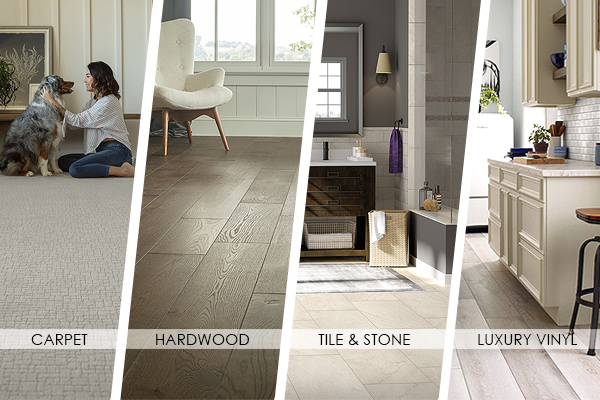
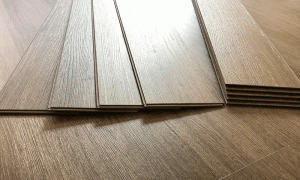 Durable: Some linoleum installed over a century ago is still wearing strong.
Durable: Some linoleum installed over a century ago is still wearing strong.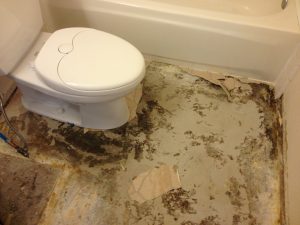 Breaks and chips easily (it is not a strong product).
Breaks and chips easily (it is not a strong product).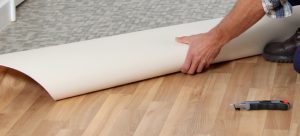 Smooth and hard: Linoleum has a flat, smooth surface and is installed directly over subflooring or wood underlayment, so it is good for wheelchairs and walkers.
Smooth and hard: Linoleum has a flat, smooth surface and is installed directly over subflooring or wood underlayment, so it is good for wheelchairs and walkers.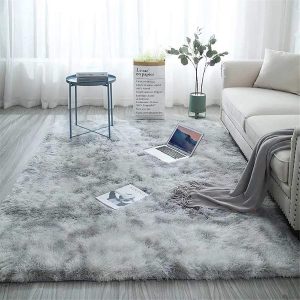 Comfort: Soft floors provide additional comfort and give a sense of luxury.
Comfort: Soft floors provide additional comfort and give a sense of luxury.